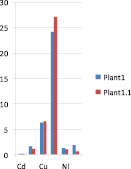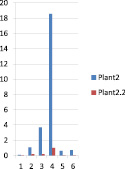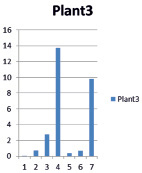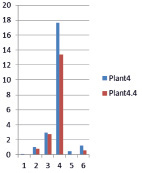At decision of environmental issues of large industrial cities a great understanding of the importance dangerous anthropogenic caused migration of pollutants, including heavy metals It is known that in addition to the natural migration of rocks from atmospheric precipitation and natural waters, heavy metals released into the environment as a result of technogenic processes. Most of them is absorbed and accumulates in the soil, and the rest migrate to the surface and underground waters. Among the important role of a barrier in the way of migration of heavy metals, in addition to soil, plants perform, so the search among these species, the most objectively reflect the degree of contamination by heavy metals, are current a task. Thus, it was definitely the concentration of heavy metals in the vegetation of Mangistau region.
The soil cover of the Mangistau region is experiencing high technogenic load related with functioning industrial enterprises oil and gas industry. The factors of pollution and violation soil advocate the use of a powerful drilling and construction equipment with high destructive effect; great length of transport communications for the export of raw materials; lack of reliability of the exploited fishing equipment and vehicles; the formation of oil and drill cuttings; high content of hydrogen sulphide in the feed; oil spills; organized and unauthorized landfill. Petrochemical pollution of soils observed in an area of the existing oil and gas fields near the infield pipeline network as a result of irrational exploitation of natural resources and raw materials. Causes of soil contamination in the oil fields are gaps pipelines, emergency blowout exploration wells, technological disturbances in the transport and storage of raw materials, the use of obsolete and worn-out equipment and processing equipment, resulting in the soil acquire new, negative signs and properties different from natural soil, required to recover high material costs[1].
Materials and methods of research. Samples were selected 4 types of vegetation and soil samples 2 in the immediate vicinity from the boundary of the well field is Zhetybai. Analysis of the presence of individual species in the composition showed that in the immediate vicinity of the oil well 95 % of the total mass of plants was Garman (other names: burial, adraspan, prairie root, Turkish paint). This weed clog pastures and grazing pastures greatly brought down in the southern steppes and deserts. grows on the slopes of the foothills, on sandy, sandy loam, clay, alkaline and saline shallow gravelly soils in the piedmont plains deserts. In clayey slopes and deserted valleys of the rivers rises in the mountains. As Garman weed is widespread in the desert near houses and wells. Not eaten by animals. Other species represented rare specimens in the samples near borehole and a sample of background section
Wormwood white land – 3-45 cm tall shrub. The whole plant was young white, later gray-greenish from arachnoid-tomentose pubescence; root thick, vertical, woody. Baskets on the legs, small, 2–3 mm long, ovoid, in the loose, fairly broad panicle; flowers (including 4–5) when ripe fruits have unbuttoned corolla purplish-pink or yellow. Decoction, alcoholic extract in the experiment accelerates blood clotting, recommended for clinical trials in the gastro-intestinal diseases. Essential oil illuminates anatomical preparations can be used as a foaming agent in the flotation of ores [2].
Peganum harmala L. Perennial herbaceous vegetation a height of about 50 cm with a powerful root of many heads of up to 2–3 m in length, departing vertically into the soil to aquifers. Stems 30–80 cm tall, branched, glabrous, green. Leaves are alternate, short, sessile, three-deep, with linear acute lobes. The flowers are yellow or white, large, single or on stalks up to three at the ends of branches. Calyx remaining in fruit, almost to the base quinquepartite share its linear, pointed, entire or slightly incised. Corolla of five petals elliptic, length of 1,5–2 cm The fruit – Spherical, somewhat flattened box, 6–10 mm in diameter.As a medicinal plant used grass harmala (lat. Herba Pegani harmalae). The raw materials harvested in the budding phase – beginning of flowering. Drying air. Repeated harvesting on the same bush are possible after 2 years Contains a significant amount of alkaloids, indole and quinazoline derivatives. Of the total alkaloids first isolated in pure form harmaline, harmine (banisterin) garmalol and L-peganin (vasicine), and in recent years – pegamin, peganol, It was found that out of alkaloids. seeds, 50–95 % are harmaline that prevails in the roots of harmine (67–74 % of the total), while the bulk of the grass is peganin (up to 78 % of total alkaloids). It was also revealed that the young roots twice alkaloids than the old, with Garmin dominates. With the development of the aerial part of the plant is reduced and the amount of alkaloids and share peganina in it, and the amount of harmine increased. The qualitative composition of alkaloids depends strongly on the place of growth of the plant. In addition to the alkaloids from the seeds of the plant are marked red colorant and drying fat oil. The herb contains protein (24 %), fatty oil (4 %) and extractives (31 %). Peganum harmala L. is known as Syrian rue, Wild rue and Harmal. P. harmala extracts are considered important for drug development, because they are reported to have numerous pharmacological activities in the Middle East, especially in Iran and Egypt. For a long time P. harmala has been used in traditional medicines for the relief of pain and as an antiseptic agent. P. harmala also have antibacterial, antifungal, antiviral, antioxidant, antidiabetic, antitumor, antileishmanial, insecticidal and cytotoxic activities and hepatoprotective and antinociceptive effects. Harmaline, harmine, harmalol, harman, quinazoline derivatives, vasicine, vasicinone, anthroquinons and fixed oils are reported from seeds and roots of this plant. This plant is used as a medicine in Turkey, Syria, Iran, Pakistan, India, Egypt.
Barnyardgrass solonchak, or Anabasis salsa (Latin Anabasis salsa.) – The form of flowering plants of barnyardgrass (Anabasis) family of amaranth (Amaranthaceae). Shrub (lat Suffrutex.) Life form (biomorph) plants; perennial floor wood-floor herb, which, in contrast to the bushes and shrubs, only the lower part of shoots bearing buds resume, stiffens and stored in the winter for many years, and the upper – grassy – annually with the onset of cold weather is dying, and with the advent of heat re-grows. Shrubs usually not higher than 80 cm, rarely they reach 150–200 cm shrubs common in arid areas – deserts and semi-deserts:. Eurotia, some species of wormwood, thistle, astragalus. Aboveground position kidney shrubs protects against overheating in the red-hot soil. In the temperate zone to the shrubs are sage, blueberry, lavender. Low-growing shrubs, whose height rarely exceeds 15–20 cm (for example, thyme), usually called shrubs [3].
Suaeda acuminata 10–75 cm high., Naked, straight, obliquely upward directed branches, often with reddish stems. Leaves glaucous, narrowly linear, multiple, flat top, bottom protruding, sharp or pointed, sometimes with bristle-shaped, very short pointed. The flowers are used. h. bisexual, clustered in dense tangles.When colored leaves and collected rare, loose, spicate inflorescence, forming a generally whisk. Perianth with lobes, fused to 2/3, in the upper half with a small sharp keels. Stigmas 2–3, very short, no longer than 0,5–0,75 mm. Seeds of both vertical and horizontal, 1–1,5 mm., Black, strongly convex, shiny and smooth. Annual plant 10–75 cm high., Naked, direct from obliquely upward directed branches, often with reddish stems [4]. Leaves glaucous, narrowly linear, multiple, flat top, bottom protruding, sharp or pointed, sometimes with bristle-shaped, very short pointed. Flowers, clustered in dense tangles. When colored leaves and collected rare, loose, spicate inflorescence, forming a generally whisk. About bashlyk flower with prominent lobes, fused to 2/3, in the upper half with a small sharp keels. Stigmas 2–3, very short, no longer than 0,5–0,75 mm. Seeds of both vertical and horizontal, 1–1,5 mm., Black, strongly convex, shiny and smooth.
Methods of Inductively coupled plasma mass spectrometry (ICP-MS). In tracing paper or glass weighing taking a sample of the sieved sample (soil) is not less than 0,5 g, quantitatively transferred into a glass for a microwave oven, for the same cup, 10 ml of nitric acid and 2 ml of hydrogen peroxide and 2 ml of hydrochloric acid and then put on microwave oven for 1 hour. After that, we take out the cups and filter the solution through a filter paper “white ribbon”. The walls of the cup is washed with bidistilled water and poured it into the same 25 mL volumetric flask, bringing the solution to a volume label. Thus, we get ready soil samples for the determination of heavy metals using ICP-MS.
The vegetation samples Artemisia terrae-albae; Peganum harmala (Peganum harmala L.) – adaryspan;) – Anabasis salsa, pointed Sweda (Suaeda acuminate) ground into slices of thickness up to 0,8 cm, the samples were dried in an oven at a temperature of 60–650 °C Air dry sample is crushed in a mill and screened through a sieve with holes diameter 2 mm. Sample preparation in plants was conducted by the above mentioned method but it was posted 0,2 g of vegetation, and the solution was added only nitric acid 10 ml.
Results of research and their discussion.
The results of analyzes to determine the concentration of heavy metals
|
Characteristics of soil contamination in the oil fields Zhetybai |
|||||||
|
Name of samples |
Cd |
Cr |
Cu |
Mn |
Ni |
Pb |
Zn |
|
Soil1 (outside sanitary protection zones deposit) |
0,111837 |
15,25779 |
5,8493 |
155,8579 |
6,044999 |
2,80699 |
14,567 |
|
soil2 (near production well) |
0,122652 |
13,1567 |
4,643379 |
160,619 |
4,829 |
3,082 |
13,2298 |
The standards of maximum permissible concentrations of harmful pollutants in soil
|
Name substances |
Maximum allowable concentration |
|
mg / kg in soil |
|
|
Lead (gross form) |
32 |
|
Copper (mobile form) |
3 |
|
Chromium (mobile form) |
6 |
|
Chromium + 6 |
0,05 |
|
Manganese |
1500 |
|
Nickel (mobile form) |
4 |
|
Zinc (mobile form) |
23 |
|
Cadmium (gross form) |
0,5 |
|
Arsenic (gross form) |
2 |
Note: * Joint Order of the Ministry of Health of RK as of 30.01.2004 № 99 and the Ministry of Environmental Protection of Kazakhstan from 27.01.2004 № 21-g.
|
Corrected data for blank and dilution results in mg/kg |
|||||||
|
Sample sites |
Cd |
Cr |
Cu |
Mn |
Ni |
Pb |
Zn |
|
Plant1 |
0,092 |
1,565 |
6,253 |
24,266 |
1,18045 |
1,862 |
17,83 |
|
Plant1.1 |
0,0947 |
1,105 |
6,50025 |
27,122 |
1,0023 |
0,6546 |
19,317 |
|
Plant2 |
0,1007 |
1,068 |
3,6893 |
18,586 |
0,6112 |
0,7234 |
12,82 |
|
Plant2.2 |
0,01012 |
0,1921 |
0,1897 |
1,0182 |
0,0214 |
0,0037 |
0,377 |
|
Plant3 |
0,07909 |
0,74516 |
2,7533 |
13,743 |
0,39717 |
0,6954 |
9,798 |
|
Plant4 |
0,08355 |
1,0213 |
2,9618 |
17,657 |
0,4708 |
1,2111 |
9,656 |
|
Plant4.4 |
0,05 |
0,809 |
2,7252 |
13,36 |
0,044 |
0,5499 |
7,425 |
Plant 1 Artemisia terrae-albae (near production well)
Plant 1.1 Artemisia terrae-albae (outside sanitary protection zones)
Plant 2 Anabasis salsa (near production well)
Plant 2.2 Anabasis salsa (outside sanitary protection zones)
Plant 3 Suaeda acuminate (near production well)
Plant 4 Peganum harmala L. (outside sanitary protection zones)
Plant 4.4 Peganum harmala L. (near production well)

Fig. 1. Artemisia terrae-albae

Fig. 2. Anabasis salsa

Fig. 3. Suaeda acuminate

Fig. 4. Peganum harmala L.
From this study it can be concluded that the concentrations of heavy metals in soil type studied were within the limits studied medicinal plants that grow in the highly industrialized area, had a concentration of heavy metals within the data of the content of heavy metals in plants are shown in Fig. 1, 2 As can be seen from the figure, white wormwood – (Artemisia terrae-albae) Peganum harmala or adraspan – Peganum harmala L. Sweda sharpened barnyardgrass solonchak, or Anabasis salsa (Anabasis salsa) accumulate zinc and copper in high degree. Its content in the paragraph number 1, from 1 to 9 samples of zinc ranges between 25,71 ± 7,65 mg / kg, 10 samples its content was 29.9 mg / kg. 11-20 samples of zinc concentration 9,19 ± 3,49 .The content of honey as shown in Figure 2 in paragraph number 1 varies from 19,89 ± 11,85mg / kg 2 item 2,18 ± 1,01 The lead content in the not too high, it was 1,33 ± 0,52 mg / kg, outside the field of sanitary protection zones 0,07 ± 0,22. Analysis of the results of the determination of cadmium in the studied species of plants also showed various accumulative capacity in Figure 1 item number 1 0,03 ± 0,01, in the number 2 point cadmium content 0,2 ± 0,03 The results of these studies have shown that too much pollution is not specified, but the comparison with 2 points the sample outside of the field, that an increase of heavy metals, respectively, increases the level of absorption of heavy metals by 1 point directly at the oil rocking. Thus, the study results indicate contamination of plants manufacturing heavy metals.
Conclusion
From this study it can be concluded that the concentrations of heavy metals in plants have studied drug concentrations of heavy metals within the data content of heavy metals in plants are shown in Figure 1,2,3,4 Thus, analysis of flora contamination by heavy metals Mangistau region shows that the highest number of pollutants found in samples near the oil and gas equipment. Background levels of heavy metals exceeded at certain points within a wide range, the most important pollutants are zinc and copper. In these terms it is necessary to develop measures to reduce the entry of heavy metals into the environment. It is characteristic of the mobile forms of heavy metals. In further studies,ecological condition. Mangistau region is necessary to monitor first and foremost elements having ratios in the maximum amount of concentration of zinc, copper
The work is submitted to the International Scientific Conference “Problems of ecological monitoring”, Italy (Rome, Venice), December 18–25, 2016, came to the editorial office оn 15.12.2016.

